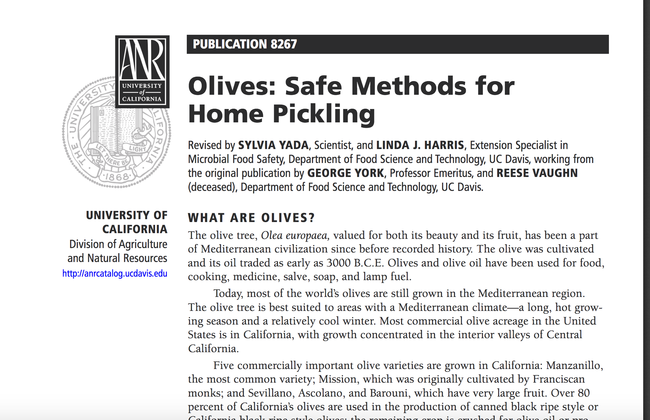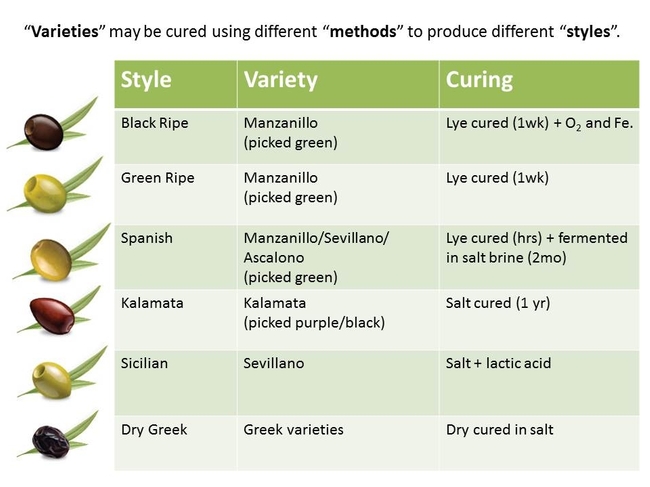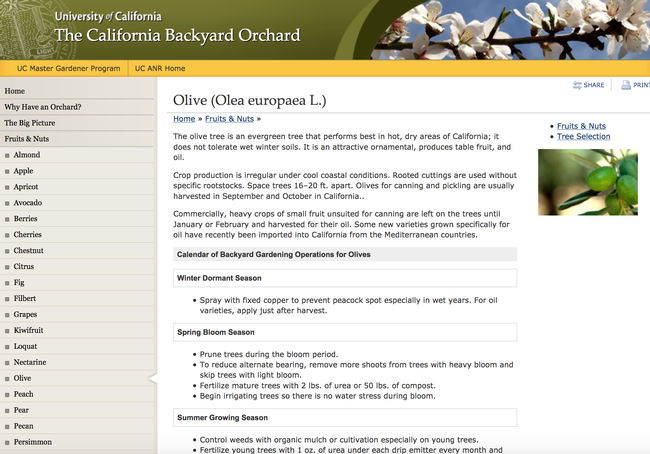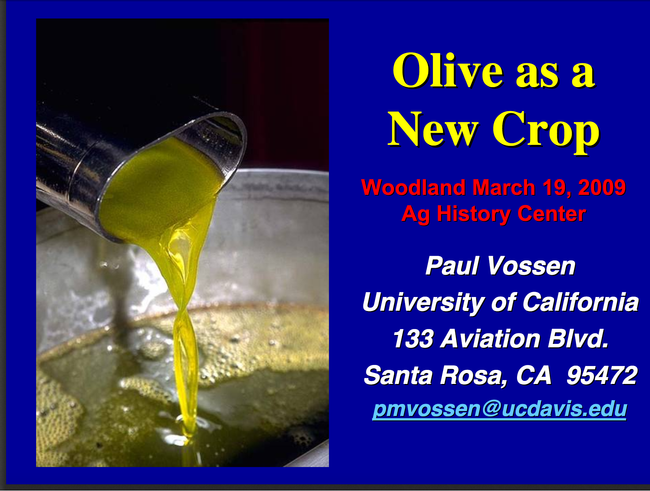By Okhoo Hanes, U. C. Master Gardener of Napa County
The olive tree (Olea europaea) is well suited to Napa Valley. The tree's Mediterranean origin makes it a natural fit for our sunny, arid and temperate climate. Our warm summers encourage fruit growth, and winter provides the necessary 200 to 300 chill hours (hours under 45°F). The olive tree is frost-resistant, withstanding temperatures down to 15°F.
Rich soil and fertilization improve fruit yield, but the olive tree tolerates poor soil. Deer do not like olive leaves, fortunately, as many a plant in the Napa Valley succumbs to their voracious appetite.
Once established, olive trees require little or no water. Still, deep watering every other week in a hot summer results in better fruit production and helps sustain the tree during drought years. Generally, a rainy winter will almost fulfill the tree's annual watering needs, unless your objective is a good fruit crop.
Extreme weather does not appear to affect olive trees drastically. Even so, growing olive trees in the Napa Valley is not entirely trouble-free.
The olive tree can be grown for both culinary and ornamental purposes. Raw olives are not edible but you can cure them or press them for oil. Branches make beautiful wreathes. In landscaping, the silvery-green olive tree contrasts nicely with dark green redwood trees and the brighter greens of oaks.
The olive tree is evergreen, low care and drought tolerant. Due to this generally unfussy habit, it makes a suitable accent patio container tree, a privacy screen or even a hedge. Dwarf varieties tend to reach six to eight feet in height, adequate for a hedge. But standard varieties can reach 30 feet in height and width. With close spacing and systematic pruning, they can create a tall, dense barrier. Olive trees in containers will need regularly watering to maintain moisture levels due to their limited root zones.
If you are growing olive trees purely for ornamental or hedging purposes, consider a fruitless variety. Then you can avoid the hassle of harvesting or cleaning up fallen fruit, the patio staining caused by dropped fruit and the necessity to spray for olive fruit fly. Fruitless varieties include Swan Hill, Majestic Beauty, Wilsonii, Bonita and Little Ollie, a dwarf type topping out at about eight feet. Although Swan Hill produces neither pollen nor fruit, other fruitless varieties may produce tiny flowers and fruit occasionally.
If you would like to cure olives, you can find a detailed recipe online from the University of California Cooperative Extension (http://anrcatalog.ucanr.edu/Details.aspx?itemNo=8267 ). Or plan to attend the U. C. Master Gardeners of Napa County food-preservation workshop on July 27 (details below).
If you would like to press your olives for oil, some commercial facilities such as Jacuzzi Winery in Sonoma accommodate home growers with small production by aggregating the fruit for pressing. For current information about local olive-mill options, contact the Master Gardener office.
Popular olive varieties for oil include Arbequina, Mission, Manzanillo, Sevillano and Frantoio.
Depending on the variety and when the olives are picked, the oil can range in flavor from peppery to buttery. Before planting olive trees for oil, educate yourself about the flavor differences. Many wineries that grow olives offer olive oil tastings and many specialty-food markets carry varietal olive oils.
Olive fruit fly is the most common pest of olive trees in the Napa Valley. It lays its eggs in the fruit, rendering the olives unusable. Do not add damaged fruit to your compost pile; discard the olives in a brown yard-waste bin. The fly was first found in Napa in 2001 and is now ubiquitous throughout the county. Preventing or minimizing the infestation is critical to slowing its spread.
If you have fruiting olive trees but don't care about harvesting the fruit, spray trees with a plant growth regulator containing ethephon (available in many nurseries) in May or June to prevent fruit set. Alternatively, water the trees with a high-pressure hose during flowering. If your trees do produce damaged fruit, harvest it and discard it. Be sure to pick up any fruit on the ground as well.
If you do want the fruit, spray trees with Spinosad, an organic control, following manufacturer's directions. Harvest early in November and pick up all fallen fruit.
The University of California website has excellent information on growing olives in the home garden. (http://homeorchard.ucanr.edu/Fruits_&_Nuts/Olive/). Paul Vossen, an olive authority and former UC farm advisor for Marin and Sonoma Counties, produced a detailed slide presentation on olive cultivation, titled “Olive as a New Crop” (http://cesonoma.ucanr.edu/files/27719.pdf). Although intended for commercial producers, the presentation's content should be of great interest and usefulness to home gardeners as well.
Workshops: U. C. Master Gardeners of Napa County will hold a workshop on “Growing Olives” on Saturday, July 14, from 9:30 a.m. to 11:30 a.m. Location will be provided after registration. Would you like an olive tree or two in your garden? Olive trees are an attractive evergreen and can provide fruit when properly cared for. Learn what to do in every season to have a healthy tree and tasty harvest. Online registration (credit card only); Mail-in/Walk-in registration (check only or drop off cash payment).
U. C. Master Gardeners of Napa County will hold a workshop on “Freezing and Dehydrating” on Saturday, July 21, from 9:30 a.m. to 11:30 a.m., at Napa Farmers Market, 195 Gasser Drive, Napa. Freezing and dehydrating are ways to preserve your summer bounty in its prime, whether you have too much ripe at once or simply want to get a head start on stocking up for winter. Join UC Master Gardeners as they discuss the benefits of each method and some different ideas for snacks and pantry staples. The workshop is free but registration is required. Online registration.
U. C. Master Gardeners of Napa County will hold a workshop on “Basic Food Preserving” on Saturday, July 27, from 10 a.m. to noon, at University of California Cooperative Extension, 1710 Soscol Avenue, Napa. Canning, freezing and drying are among the most basic food preserving methods. It is important to practice safe methods and to stay up-to-date with the most reliable d information about food safety. Master Food Preservers will discuss each process, the equipment required and hazards to avoid, and give demonstrations and recipes. Online registration (credit card only); Mail-in/Walk-in registration (check only or drop off cash payment).
Master Gardeners are volunteers who help the University of California reach the gardening public with home gardening information. U. C. Master Gardeners of Napa County ( http://ucanr.edu/ucmgnapa/) are available to answer gardening questions in person or by phone, Monday, Wednesday and Friday, 9 a.m. to Noon, at the U. C. Cooperative Extension office, 1710 Soscol Avenue, Suite 4, Napa, 707-253-4221, or from outside City of Napa toll-free at 877-279-3065. Or e-mail your garden questions by following the guidelines on our web site. Click on Napa, then on Have Garden Questions? Find us on Facebook under UC Master Gardeners of Napa County.
Attached Images:



